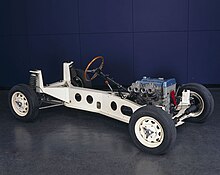Central tubular frame


As a central tubular frame is called a type of vehicle frame in automobile construction , in which a bearing, center tube takes up the other vehicle elements. Another common term for this is the Tatra concept .
In multi-lane motor vehicles (motor vehicles), this tube is used in the series production of cars as a load-bearing and force-absorbing element, with a non-self-supporting structure (also made of plastic instead of steel ). The central tubular frame was invented by the car designer Hans Ledwinka .
Frame instead of a self-supporting structure
Modern mass-produced automobiles have generally had a self-supporting body since the 1950s, i.e. the spatial structure of floor panels, floor and roof pillars , together with the connecting pillars , the windshield frame and the roof form a structural unit. It “carries” the entire vehicle and all of its components. Before this time, however, the “frames” were separate components of a floor assembly entrusted with the load-bearing task, on which the body was placed “non-load-bearing”, i.e. without any structural task of absorbing forces.
The development and construction costs for self-supporting steel bodies are so great that tens of thousands of vehicles are required to amortize the high costs, especially of the steel pressing tools .
With smaller series, especially in sports car construction, one often takes a different approach: one continues to separate the functions of a load-bearing frame from those of the body.
variants
The central tubular frame is one of the several construction options for a frame, i.e. for the load-bearing structure under a non-load-bearing body. Other frame types are the tubular space frame , the platform frame and the ladder frame .
The most important feature of a central tubular frame is the eponymous central tube , usually made of steel. It can have a circular cross-section, but also be designed in other cross-sections, for example as a rectangular box. All other elements of the floor assembly, such as the chassis, are attached to it. As a rule (in car construction) there are cross members in front of and under the seats , in the position of the end of the passenger cell and on the axles. The side bars and floor panels can also be welded to the central tube. Often a separately built subframe is bolted to the structure of a bulkhead at the front ; this design is often found in Italian high-performance sports cars. A similar construction can also be found in the Jaguar E-Type .
application
The Tatra 11 developed by Hans Ledwinka was the first car with a central tubular frame. Until recently, Tatra trucks have been built according to his concept .
A central tubular frame is not only found in small series vehicles. In the 1930s, Tatra developed and produced series vehicles with a central pipe and air-cooled rear engine ( Tatra 77 , Tatra V 570 ) and thus served at least as a model for the later VW Beetle . This had a (modified) central tubular frame. The tunnel in which the shift rod, the clutch cable and some of the brake cables run (until 1962) is a central tube. However, VW spoke of a “platform frame”, because the tunnel is part of the base plate of the car, the body screwed onto it is open at the bottom.
literature
- Wolfgang Siebenpfeiffer (ed.): Lightweight technologies in automobile construction. Materials - Manufacturing - Concepts, Springer Fachmedien, Wiesbaden 2014, ISBN 978-3-658-04024-6 .
Web links
- The framework (accessed on May 20, 2016)
- Lightweight chassis development (accessed on May 20, 2016)
